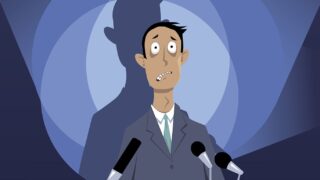You can’t give an effective presentation (or do much of anything at work, for that matter) without looking and sounding credible. And fortunately, there are many ways for presenters to appear confident and sound like they know their stuff.
Unfortunately, there are also many ways to do the opposite. Unraveling an effective presentation can be as simple as saying the wrong thing. Here are three common phrases that can sap your credibility if you don’t make an effort to avoid them.
Next Article
The 3 Worst Things to Say in a Presentation
The Top 5 Mistakes That Will Kill Your PowerPoint Presentations
“Hahahaha, I’m so nervous!”
We’ve all heard this, and maybe said it ourselves. The idea is well-intentioned: to kick off with some self-deprecation in an honest attempt to build empathy and launch an effective presentation rapport. Your audience may laugh a little, but the actual outcome? You’ve just told your audience to lower their expectations for the rest of your presentation. Who wants to watch a nervous presenter? They want to hear from a professional.
When I teach effective presentation skills to MBA students, they often say after a presentation that they felt nervous. But their classmates invariably tell them that they didn’t look nervous. Feeling nervous and showing nervousness are very different things. Maybe you look nervous to 30% of the audience. But after you’ve told them how anxious you feel, 100% of the audience will think that you look it.
The simplest solution? Just don’t say it. The better solution? Actually feel confident about your content by putting effort into it. Create something you know will resonate, then rehearse it well. The better you feel about your presentation, the less nervous you’ll feel delivering it. When in doubt, start your presentation by telling a story–it’s not only a compelling way to draw your listeners in, but to relax you as well.
There are other habits you can cultivate to curb pre-presentation jitters. Drink water to avoid a dry throat. As you get going, chat with the audience to build rapport, and channel any lingering nervous energy into passion. But the fact is that feeling nervous is normal, so at a minimum, try not to draw attention to it.
“Sorry if you can’t read this slide very well…”
This phrase, typically followed by something like, “I know the writing is too small” or “it’s really busy,” sabotages your presentation in two ways. First, it declares that you didn’t do your job; you created slides that are unclear and hard to understand. This cuts into your credibility as someone who can create high-quality work. But the bigger mistake is that you’re admitting you know that you created subpar content, but you decided to inflict it on your audience anyway. How should that make them feel?
Obviously, the best way to avoid this is just to design better slides–ones that are more visual and have less text. Using a large font size forces you to become more economical with your words. Less is more.
Rehearsal also matters. Test your content before presentation day. Connect your laptop to a projector to see how it looks on a big screen. Test it with coworkers and get their feedback. Then use all that to improve your slides and create clear, compelling content for an effective presentation that you don’t need to apologize for or make excuses about.
“I went over time, so we’ll have to skip the Q&A. Sorry!”
Maybe you didn’t manage time well, maybe you love your own voice, maybe you didn’t actually want to take questions. Whatever the reason, you’ve now disappointed your audience by wasting their time and taking away their chance to be part of the conversation.
There are two ways to avoid this. First, practice delivering your presentation in less than the time you’ve been given. Speaking for 20 minutes? See if you can do it in 15, plus time for a Q&A. This gives you a buffer, and nobody will fault you for finishing early. Second, invite questions throughout the presentation, not just at the end. An effective presentation is like a dialogue–it’s interactive.
In fact, consider whether you need to end with a Q&A session at all. It’s sometimes better to wrap up on a high note with a strong message than an energy-sapping, “Thanks for the great questions, that’s all the time we have!”
But if there’s a limit to how much you’ll be able to prepare, merely avoiding these three common expressions is a great start. When you see your audience enjoying your presentations and feeling confidence in you, you’ll feel even more confident and successful the next time.
This article was originally published in Fast Company.





